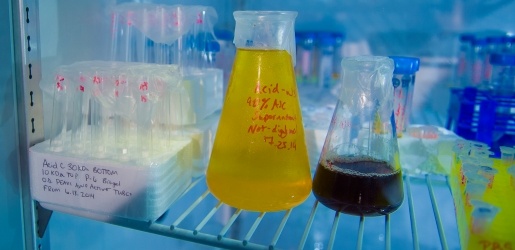Industrial Wastewater Treatment: Custom-made Solutions for Complicated Wastewater Obstacles
Industrial Wastewater Treatment: Custom-made Solutions for Complicated Wastewater Obstacles
Blog Article
Just How Fluid Garbage Disposal Works: An In-depth Introduction of Methods and Technologies Utilized

Summary of Liquid Waste Types
The complexity of fluid waste kinds necessitates a thorough understanding of their attributes and effects for disposal. Liquid waste can extensively be classified into numerous kinds, consisting of industrial, local, agricultural, and harmful waste. Each category displays distinct residential properties, requiring details administration techniques to alleviate environmental and health dangers.
Industrial fluid waste stems from producing procedures and often contains a series of contaminants, such as heavy steels, solvents, and natural compounds. Municipal fluid waste, mainly making up wastewater from homes and industrial facilities, consists of organic matter, nutrients, and microorganisms (industrial wastewater treatment). Agricultural fluid waste, consisting of drainage from ranches, may contain fertilizers, pesticides, and pet waste, posturing dangers to water top quality and communities
Hazardous fluid waste is identified by its poisoning, reactivity, or prospective to create injury. Comprehending these diverse fluid waste types is crucial for developing effective disposal approaches and guaranteeing compliance with ecological regulations.
Physical Treatment Approaches

Testing is the initial step, where bigger fragments and particles are removed from the fluid waste using screens or grates. In sedimentation storage tanks, heavier fragments work out at the base, forming a sludge layer, while the cleared up liquid can be further treated.
Filtering is an additional essential approach that includes passing the liquid via porous products, such as sand or membrane layers, to record smaller fragments. This step enhances the high quality of the liquid, making it ideal for succeeding therapy procedures.

Chemical Therapy Strategies
Chemical therapy techniques are important for efficiently handling liquid waste, especially in resolving dissolved and colloidal impurities that physical methods may not sufficiently eliminate. These strategies make use of numerous chemical representatives to reduce the effects of, speed up, or change hazardous substances right into less unsafe kinds.
One usual approach is coagulation and flocculation, where chemicals such as alum or ferric chloride are added to advertise the aggregation of suspended fragments. This procedure improves sedimentation, enabling much easier removal of the resulting sludge. Additionally, oxidation procedures, using agents like chlorine or ozone, are employed to damage down complex organic substances and pathogens, rendering the waste much safer for discharge or more treatment.
Neutralization is one more essential technique, which changes the pH of acidic or alkaline waste streams to neutral levels, protecting against prospective harm to downstream systems and the environment. In addition, progressed oxidation processes (AOPs) make use of combinations of oxidants and ultraviolet light to weaken consistent pollutants, attaining a higher level of therapy performance.
Biological Treatment Processes
Biological treatment processes play an important function in the administration of fluid waste by making use of microbes to disintegrate raw material and decrease contaminant levels. These procedures can be generally categorized into cardiovascular and anaerobic therapies, each using certain microbial areas to attain effective waste deterioration.
Cardio therapy involves using i was reading this oxygen to promote the break down of organic products by microorganisms. This procedure is frequently implemented in activated sludge systems, where oygenation tanks supply a favorable setting for microbial growth, resulting in the oxidation of organic contaminants. The resultant biomass can be separated from treated effluent with sedimentation.
On the other hand, anaerobic therapy happens in the lack of oxygen, depending on various germs to damage down natural matter. This approach is especially useful for high-strength waste, as it creates biogas, a renewable resource resource, while decreasing sludge production. Technologies such as anaerobic digesters are often employed in commercial and metropolitan applications.
Both anaerobic and cardio biological treatments not just decrease the ecological influence of fluid waste yet also promote source recuperation, making them necessary components of sustainable waste monitoring techniques. Their performance, flexibility, and effectiveness support their prevalent implementation throughout numerous fields.
Arising Technologies in Disposal
Innovative methods to fluid garbage disposal are quickly progressing, driven by improvements in technology and an increasing focus on sustainability. Among these arising innovations, membrane bioreactors (MBRs) have obtained grip for their capability to integrate biological treatment with membrane filtration, resulting in high-grade effluent here that can be recycled in various applications. MBRs enable smaller impacts and a lot more reliable procedures compared to conventional systems.
One more appealing development is using anaerobic digestion integrated with nutrient healing modern technologies, which not only treats liquid waste however additionally produces biogas and recoups useful nutrients like nitrogen and phosphorus. This dual benefit improves source performance and decreases ecological effect.
Additionally, progressed oxidation processes (AOPs) are being adopted for the degradation of complex natural contaminants. These approaches use effective oxidants and drivers to damage down impurities at the molecular degree, using an extremely reliable service for difficult waste streams.
In addition, the integration of expert system and artificial intelligence in waste administration systems is maximizing operational efficiency and predictive upkeep, causing decreased costs and boosted environmental compliance. These technologies reflect a significant change in the direction of even more reliable and sustainable liquid garbage disposal techniques.
Conclusion
In conclusion, reliable liquid waste disposal necessitates an extensive understanding of numerous techniques and technologies. By continually advancing these approaches, it ends up being possible to deal with check these guys out the expanding challenges connected with fluid waste, ultimately adding to environmental protection and source recuperation.
Fluid waste disposal is an essential element of environmental monitoring, calling for a comprehensive understanding of various techniques and technologies customized to various waste kinds. Liquid waste can extensively be categorized into several types, including industrial, metropolitan, farming, and hazardous waste. Agricultural liquid waste, including drainage from ranches, might have plant foods, chemicals, and pet waste, presenting dangers to water high quality and ecosystems.
Various physical treatment approaches play a vital duty in managing liquid waste efficiently - industrial wastewater treatment.In final thought, effective fluid waste disposal necessitates a comprehensive understanding of different techniques and innovations
Report this page